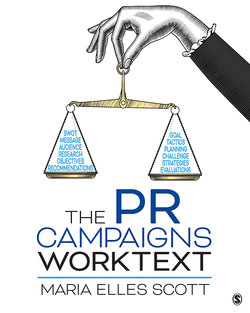Читать книгу The PR Campaigns Worktext - Maria Elles Scott - Страница 10
На сайте Литреса книга снята с продажи.
Chapter 1 Getting Started Campaigns What Is a PR Campaign?
ОглавлениеExamples of Public Relations (PR) campaigns are traced back to medieval times, periods throughout history with religious wars, times when new countries and governments were emerging. Campaigns have always been a way to inform and persuade the masses. Specifically, in the United States, examples of campaigns are well documented beginning in the 1700s and 1800s as the United States was positioning itself on the world’s stage, creating alliances and harnessing its own people to work is a collective against a common enemy. During the Revolutionary War, there are many who believe that the actions of Samuel Adams were strategically set to position the British in a poor light using terms like Boston Massacre and disseminating information to the public with a clear agenda.
Public Relations campaigns as we know them today have been around since the creation of modern PR practice, which began at the start of the 1900s. Historic figures in PR such as Edward Bernays, Ivy Lee and Betsy Plank all influenced how modern PR campaigns are conducted. In the 1998 biography of Edward Bernays by Boston Globe reporter Larry Tye titled “The Father of Spin,” Bernays’ career and accomplishments are well documented. In addition to creating an outline for propaganda techniques, ethics for practitioners and more, Bernays was very influential in creating the eight-step process to create a Public Relations plan on which most campaigns are loosely based. This process includes Objectives, Situation, Strategy, Audience, Tactics, Timeline and/or Calendar, Budget and Evaluation.
Modern PR campaigns present solutions to one goal. Throughout history, these goals often helped change the ideas of war, persuade the masses, build brands, impact outcomes, start movements, end conflicts and much more. Broken down into measurable objectives, the tactics used to create successful campaigns are skills practitioners constantly fine-tune.
A Public Relations Campaign Is:
A PR campaign is a communication plan—a strategically chosen set of various communication media platforms—that seek to influence a specific target audience or audiences. Communication plans are simple, cohesive, power pieces of persuasion. They build a case on facts and insights that demonstrate to a client why the course chosen is the correct one to yield the desired results to the target audience.
A PR campaign is conducted to solve a problem or take advantage of an opportunity. The issue solved or opportunity gained must benefit both the organization and the public—meaning it’s a win-win. The implication is that if the resulting situation is a win-lose, the outcome is often lose-lose. In other words, an organization is not likely to thrive long term without listening to and serving its public, both internal (employees, stakeholders, board of trustees, volunteers) and external (clients, customers, members) in the short term.
A Public Relations Campaign Is Not:
A PR campaign is not an advertising blitz. Advertising is frequently associated with the word campaign, but remember that advertising is usually PAID. The PR campaign employs many methods of communication including media relations (utilizing tactical PR writing such as media advisories, media alerts, media pitches, press releases, etc.), social media, publicity and other methods, all of which are not paid forms of media. An effective PR campaign typically utilizes a range of traditional and non-traditional media and employs influence by opinion leaders and the community.
A PR campaign is not blind propaganda. In modern political discourse, there is almost always an underlying thread of propaganda and influence of mass audiences. Propaganda, at its core practice, relies on generalizing the appeal to the audience evoking collective emotions, is often devoid of facts, evidence, or reality and relies on defamation. PR campaigns require credible facts that the public can understand, evaluate and utilize. The target audience is free to choose and accept the information and therefore act or deny the information. The success of the persuasion is based on action or inaction.
A PR campaign is not spin or hype. Spin usually refers to efforts to tilt the public perception in ways favorable to a political candidate or product. Unfortunately, it has a negative connotation and is often synonymous with the practice of PR. When used, spin usually means the twisting of the truth to only highlight the positive and “dizzy” the audience. The term hype is derived from hyperbole, which is an exaggeration to impress and evoke a strong response. No legitimate PR campaign achieves successful goals and hits the marks with the objectives using spin or hype. Do successful campaigns based in hype exist? Of course. But it’s important to differentiate that in the age of digital information, flash and buzz do not create a long-term lasting campaign. Weak arguments and tools aiming to just bewilder or bedazzle are not going create a lasting impression that has measureable results in the long-term. What practitioners often see is glitz and buzz are often followed by nay-sayers and contradiction, which puts the client in the center of confusion or worse a cloud of controversy and ultimately never leads to success.
A PR campaign is also not a PR program for a company. A PR program is a long-term strategy that should incorporate the ethics of an organization, strategies for rolling-out new information, handling a crisis and sticking to a brand. Within a PR program, a company can often have one or several PR campaigns a year for various reasons—ultimately to achieve a goal. An example of this is M&M-Mars refreshing its brand in the 1990s and inviting the public to pick a new color for an M&M. The public voted to remove the tan M&M and create a blue M&M. This was an extremely successful campaign for the brand and led to another global search for a new color—purple in 2002; M&Ms characters in 2007; and in 2010 personalized M&Ms.
